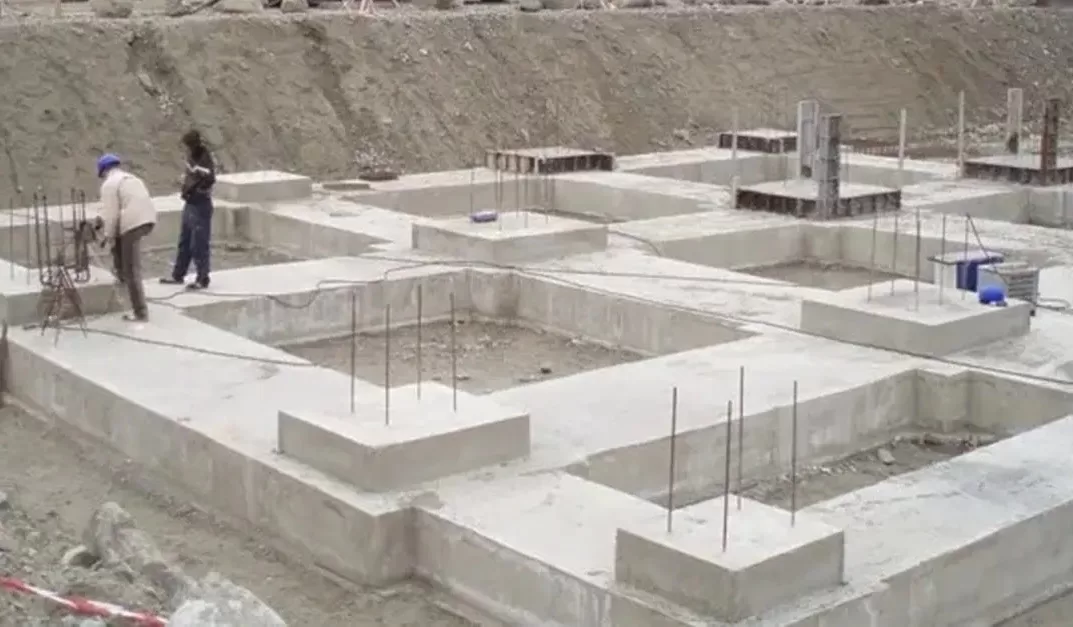The foundation serves as the primary support system for any building structure. Positioned at the base of the building, it makes direct contact with the soil and bears the responsibility of securely transferring all structural loads to the ground. Its fundamental purpose is to provide essential support and cohesion to the structure above it. Despite our everyday perception, the ground beneath us is not entirely stable, and it often lacks complete solidity. A building merely placed on the bare earth is susceptible to cracks and damage caused by natural forces over time. A well-constructed foundation enhances the building’s ability to withstand external forces and ensures the safety of its occupants.
Various Foundation Types for Buildings and Structures
Foundations in building construction are categorized into two main types: shallow foundations and deep foundations. Let’s explore the various types within each category:
Shallow Foundations:
Shallow foundations are typically located near the surface of the finished ground, usually where the depth of the foundation (referred to as Df) is less than both the width of the footing and 3 meters. While these guidelines are not strict rules, they serve as general principles. Essentially, if surface factors, like loading or soil conditions, can impact a foundation’s bearing capacity, it is categorized as “shallow.” Shallow foundations, also known as “spread footings,” encompass various types such as isolated footings (pads), strip footings, and rafts.
These foundations, often referred to as footings, are positioned beneath the lowest part of a structure. Footings are the initial structural components constructed after excavating the ground. Typically, the depth of a shallow foundation is less than its width.
Shallow foundations are frequently preferred due to their cost-effectiveness and relative ease of construction. However, designing these foundations requires a thorough site investigation and detailed knowledge of the subsurface strata to ensure their performance and prevent potential future issues.
Here are some common types of shallow foundations:
- Spread Footing: Spread footings are individual, isolated supports beneath each column or load-bearing wall of a building. They distribute the building’s weight directly to the soil. Spread footings come in various shapes, including rectangular, square, and circular, depending on the design and load requirements.
- Strip Footing: Strip footings are continuous concrete strips that run along the length of load-bearing walls. They support multiple columns or wall loads and are particularly useful for distributing the load from walls or closely spaced columns.
- Combined Footing: Combined footings are used when two or more adjacent columns have closely spaced footings that merge into a single, wider footing. This type of footing helps distribute the load effectively when columns are situated close to one another.
- Mat or Raft Foundation: A mat or raft foundation is a large, continuous concrete slab that covers the entire footprint of a building. It evenly spreads the building’s load across a broad area of the soil. Mat foundations are commonly used in areas with poor soil bearing capacity or for heavy industrial structures.
- Slab-on-Grade: Slab-on-grade is a type of shallow foundation typically used in residential construction. It consists of a single, reinforced concrete slab that is poured directly on the ground surface. Slab-on-grade foundations are often used for one-story or split-level homes.

Shallow foundations are chosen based on factors such as the building’s design, the load it will carry, and the soil conditions at the construction site. Proper design and construction of shallow foundations are crucial to ensure the stability and safety of the building. Engineers and architects carefully consider soil tests, structural requirements, and local building codes when selecting the appropriate type of shallow foundation for a specific project.
Deep Foundations:
A deep foundation is a specific type of foundation that is positioned at a significant depth below the ground surface, allowing it to effectively transfer the structural loads deep into the earth. Typically, the depth-to-width ratio of such a foundation exceeds 4 to 5.
Constructing a deep foundation is a more intricate and costly process compared to shallow foundations. Nevertheless, when confronted with challenging conditions like poor soil quality at shallow depths, substantial design loads, or site limitations, opting for a deep foundation often proves to be the most practical solution. Deep foundations come into play when the soil’s bearing capacity near the surface is inadequate. In such cases, they facilitate the vertical transmission of the load from the superstructure to the deeper, more supportive layers of the soil.
- Pile Foundation: Pile foundations involve the installation of long, slender structural elements (piles) deep into the ground. Piles can be made of materials like concrete, steel, or wood. They rely on the friction and bearing capacity of the soil or rock they penetrate to support vertical loads. Pile foundations are commonly used in various construction projects, including high-rise buildings, bridges, and waterfront structures.
- Pier Foundation: Pier foundations consist of vertical columns or piers that are embedded deep into the ground to support the structure above. They are often used in coastal areas, where they can resist the forces of waves and water currents. Pier foundations are also suitable for elevated structures like houses in flood-prone regions.
- Caisson Foundation: Caisson foundations, also known as drilled shafts or piers, are large-diameter, deep foundation elements that are excavated and filled with concrete or reinforced with steel. They are commonly used for structures like bridges, towers, and skyscrapers. Caissons are designed to penetrate into stable soil or rock layers.
- Screw Piles or Helical Piles: Screw piles, also called helical piles, are deep foundations consisting of helical-shaped steel shafts that are rotated into the ground. They are used when the soil conditions are suitable for helical installation. These piles are versatile and have applications in various construction projects, including residential and commercial buildings.
- Sheet Pile Wall: Sheet pile foundations involve driving interlocking sheets of steel or concrete into the ground to create retaining walls, cofferdams, or bulkheads. They are often used in waterfront and marine construction projects to prevent soil erosion and control water levels.

Deep foundations are chosen when the bearing capacity of the shallow soil is inadequate or when the structure needs to be anchored to deeper, more stable layers. The selection of the appropriate type of deep foundation depends on factors such as soil conditions, structural requirements, and the project’s location and purpose. Proper engineering design and construction techniques are essential to ensure the stability and safety of deep foundations.
Conclusion
Foundations are the crucial building blocks upon which the stability and integrity of structures are built. Whether shallow or deep, the selection of the appropriate foundation type depends on factors such as soil conditions, structural requirements, and site-specific constraints.
Shallow foundations, situated near the surface, are often employed for their cost-effectiveness and simplicity in construction. On the other hand, deep foundations, reaching greater depths beneath the ground, become essential when dealing with challenging soil conditions, heavy loads, or specific project demands. While the construction of deep foundations may be more complex and costly, their ability to securely transfer structural loads to deeper, more stable layers of the earth makes them a vital solution in various construction scenarios.
Ultimately, the choice between shallow and deep foundations is a critical engineering decision that ensures the safety, longevity, and performance of structures, and it must be made with careful consideration of the unique characteristics and requirements of each construction project.





